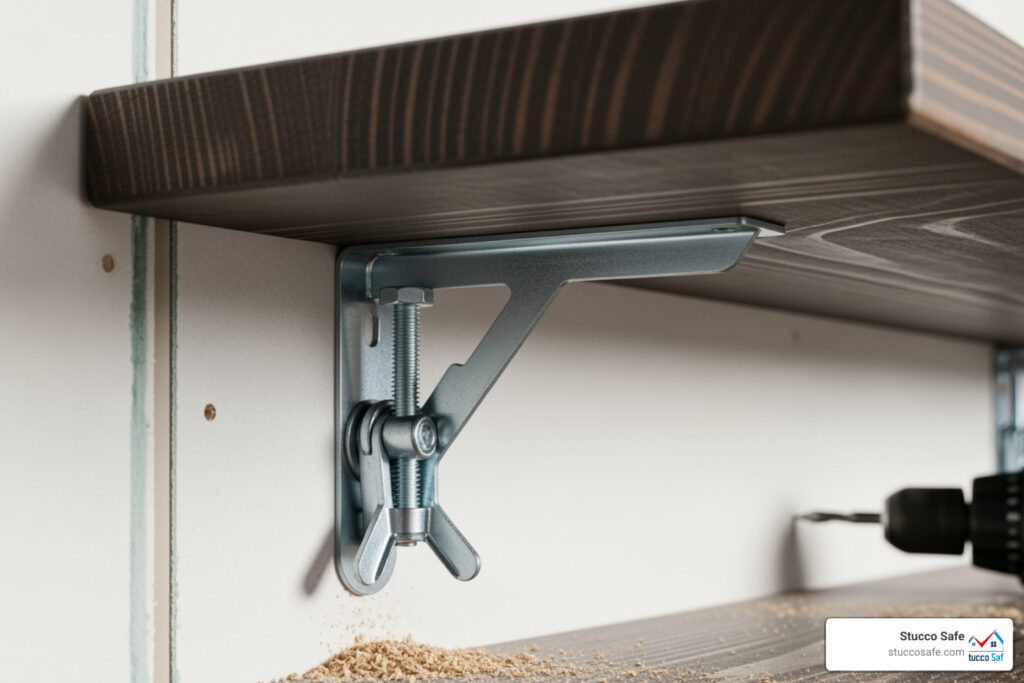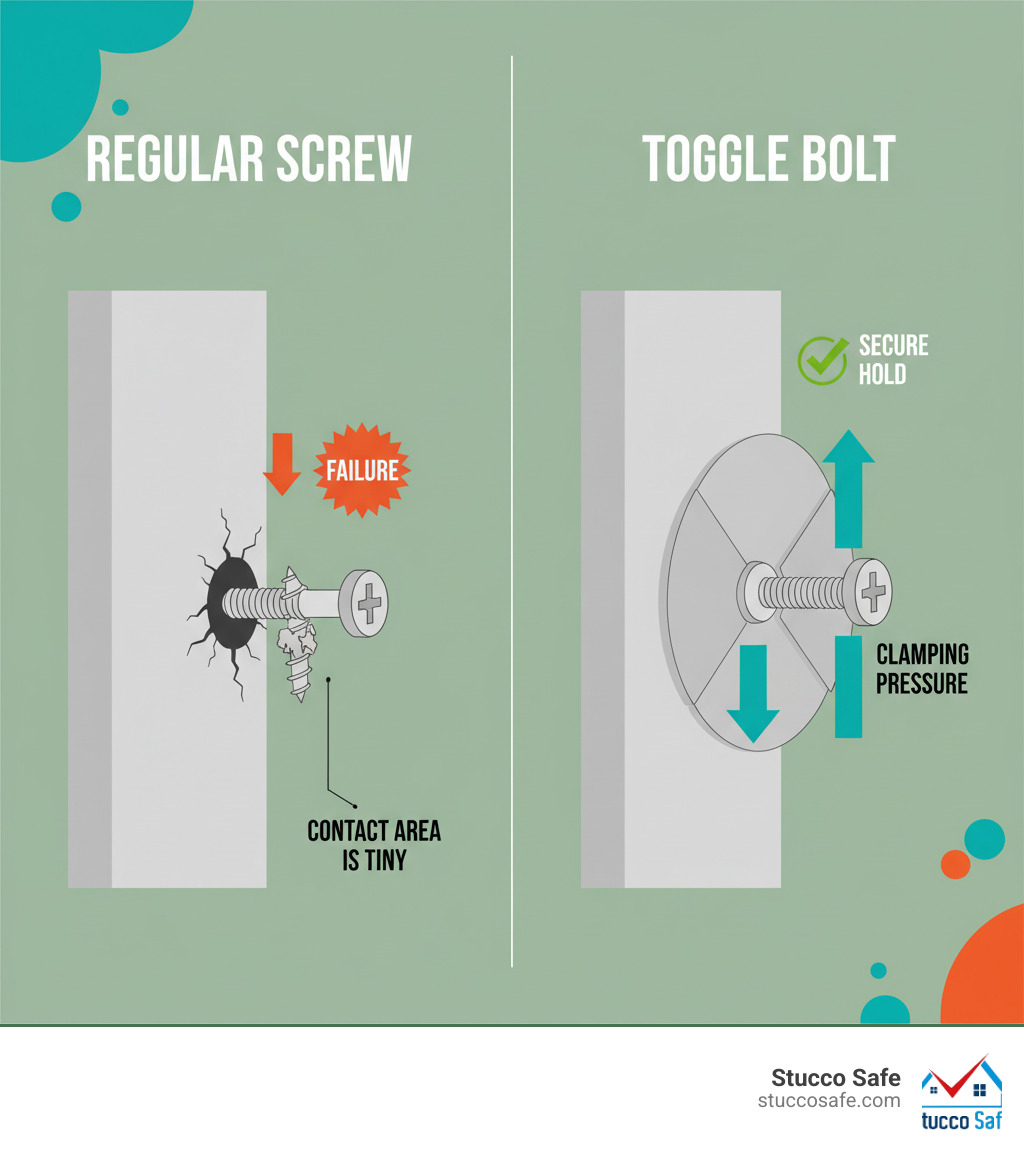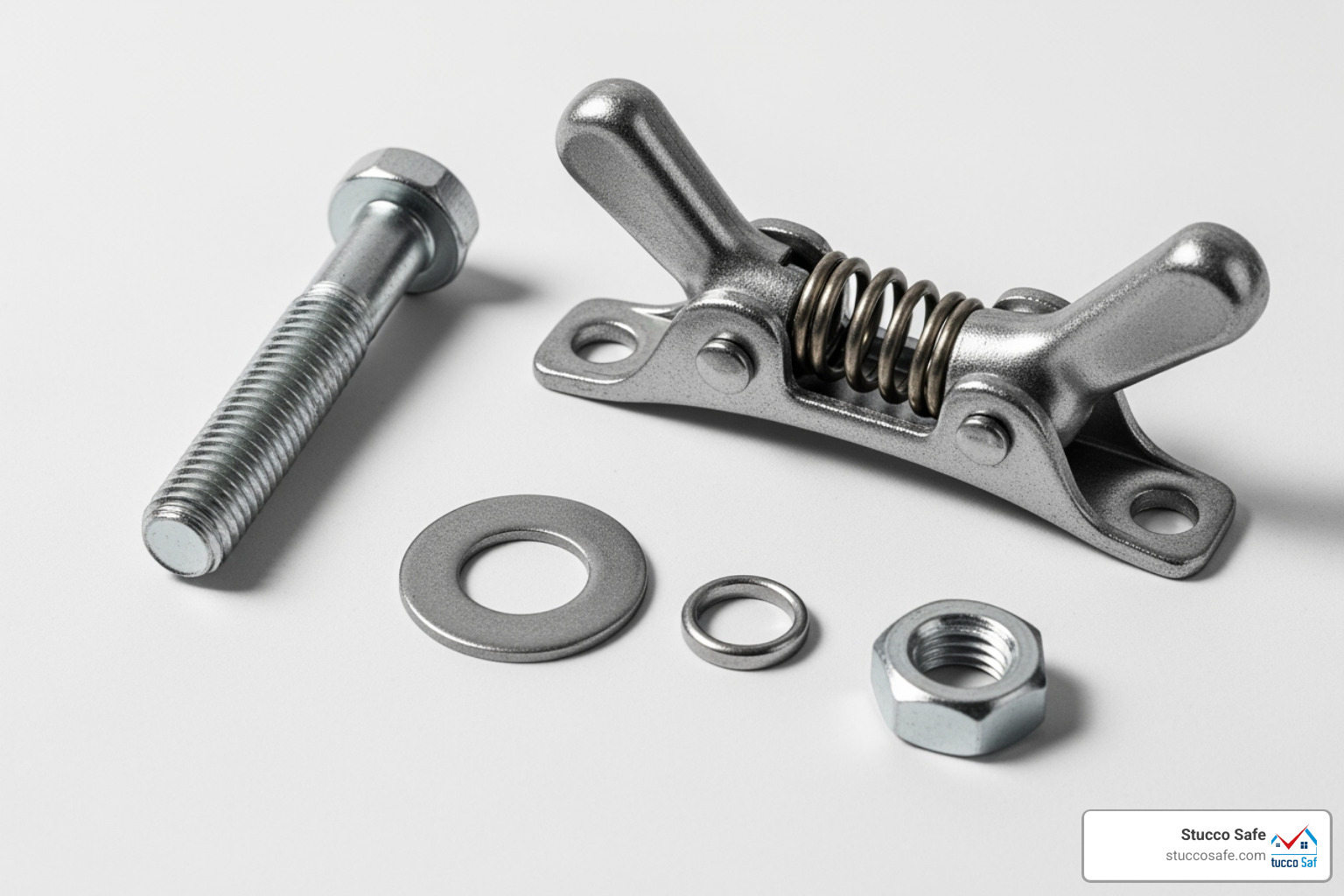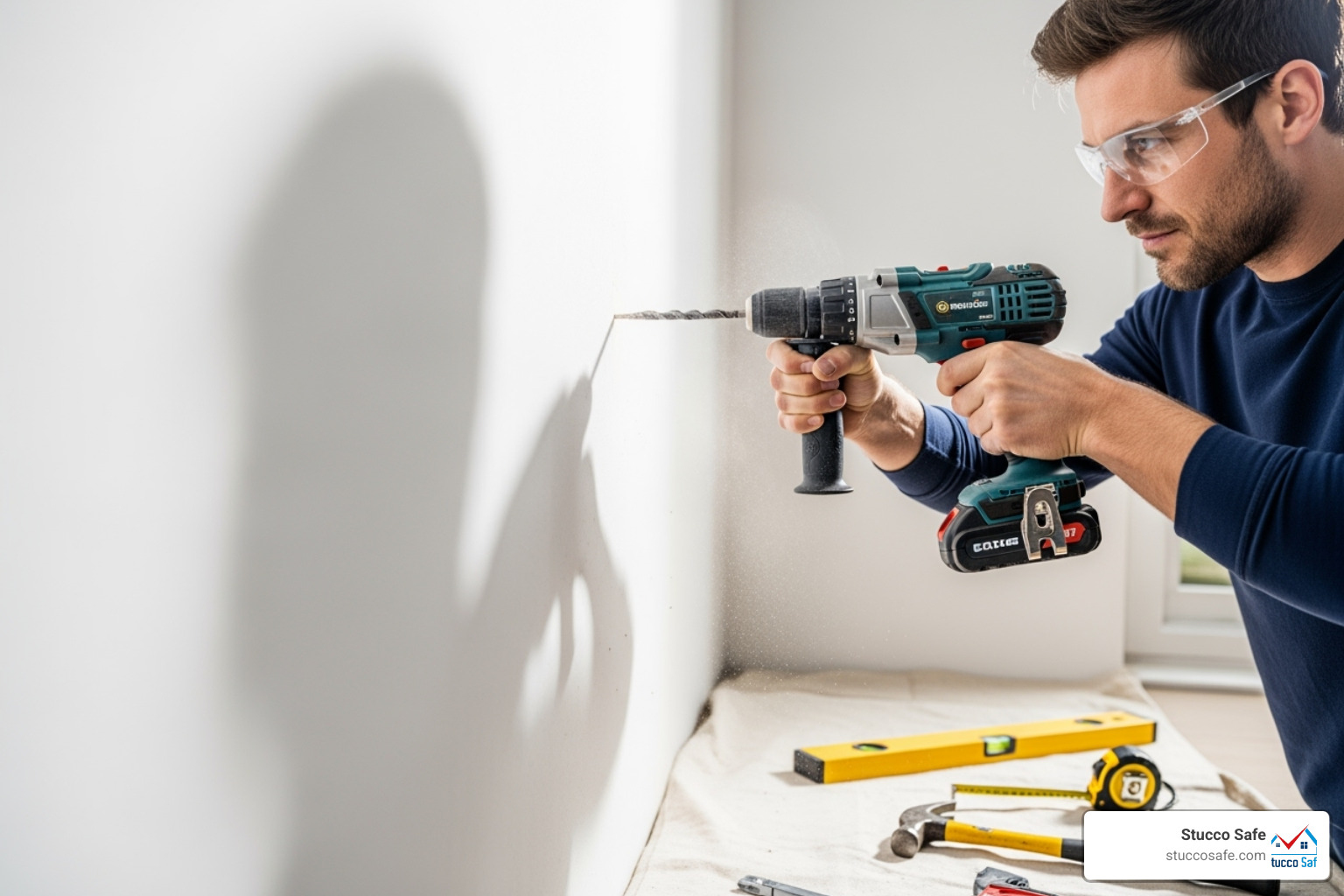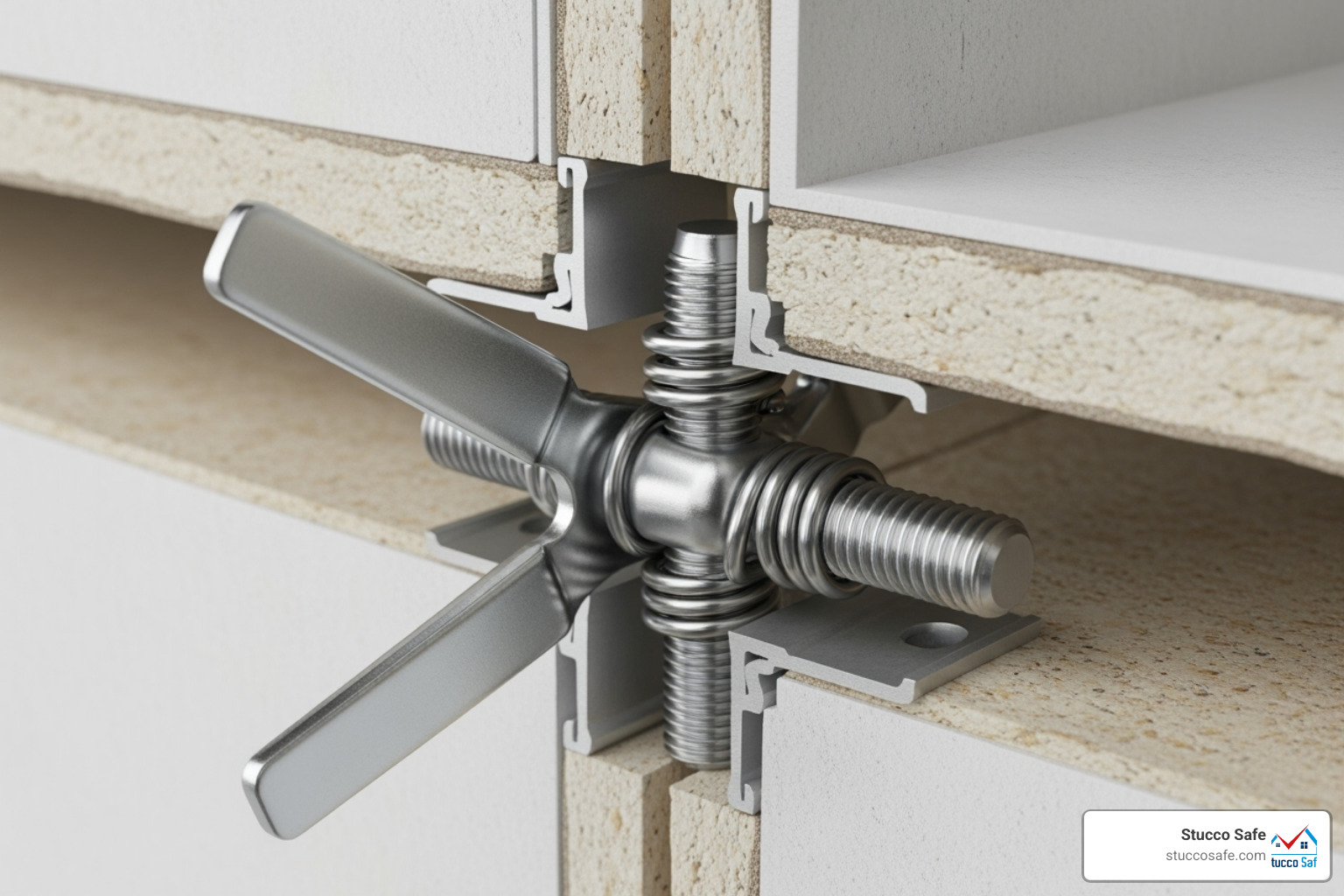How do toggle bolts work: Ultimate Guide 2025
The Heavy-Duty Hero for Hollow Walls
How do toggle bolts work? They use spring-loaded metal wings that fold to pass through a drilled hole, then spring open behind the wall. Tightening the bolt clamps these wings against the back of the wall, distributing weight over a large area. This creates a secure anchor that can support heavy loads in hollow materials like drywall.
Quick Answer:
- Insert – Wings fold flat to fit through a pre-drilled hole.
- Expand – Wings spring open once they pass through the wall.
- Secure – Tightening the bolt pulls the wings flush against the back of the wall.
- Hold – The expanded wings distribute weight across a wide area, preventing pull-out.
If you’ve tried to hang a heavy mirror or TV mount on drywall only to have it fail, you know that regular screws don’t have enough grip in hollow walls. They only grab a thin layer of material and pull out easily.
That’s where toggle bolts become your best friend. Unlike basic anchors, toggle bolts work behind the wall, spreading the load across a much larger surface. This allows them to hold 50 to 200 pounds or more, depending on the size and wall condition. If you’re mounting anything over 40 pounds on a hollow wall without a stud, toggle bolts are your strongest option.
I’m Gabe Kesslick. With over 20 years in building envelope inspection, I’ve seen countless failures from improper anchoring. At Stucco Safe, my team and I correct these issues, preventing moisture intrusion and structural damage in residential and commercial properties.
What Is a Toggle Bolt and How Does It Differ from Other Anchors?
Think of holding a bowling ball with your fingertips versus cradling it in your arms. That’s the difference between a regular screw in drywall and a toggle bolt. One concentrates stress on a tiny point, while the other spreads weight across a large area.
A toggle bolt is a fastener designed for hollow walls. It creates a strong anchor point by expanding behind the wall material, where it matters most.
A traditional toggle bolt has two parts: a machine screw and spring-loaded metal wings, sometimes called “butterfly anchors.” The screw threads through your item and connects to the wings. The hinged wings fold flat to push through the wall, then snap open on the other side.
The Core Mechanism: How do toggle bolts work?
The genius of how toggle bolts work lies in leverage and load distribution. After drilling a hole large enough for the folded wings, you push them through. Once inside the hollow wall cavity, the spring mechanism snaps the wings open.
As you tighten the screw, it pulls the open wings firmly against the back of the wall. This creates a strong clamping force, sandwiching the wall material between the wings and your mounted item. The wings distribute the load over a large area, preventing the fastener from ripping through fragile drywall or plaster. This is why toggle bolts excel where other anchors fail and are designed specifically for hollow walls where you can’t use a stud.
Toggle Bolts vs. Other Common Wall Anchors
Understanding the differences between wall anchors helps you choose the right one for the job.
Plastic expansion anchors: These simple plastic sleeves expand inside the drilled hole to create friction. They’re suitable for lightweight items up to 25 pounds, like small pictures, but offer minimal pull-out resistance for heavier objects.
Molly bolts: These metal sleeves flare out behind the wall as you tighten the screw, creating a clamp. They are good for medium-weight items (25-50 pounds) like towel racks or small shelves. Some types allow you to remove and reinsert the screw.
Toggle bolts: The heavy-duty option, supporting 50 to 200+ pounds. Traditional spring-wing toggles are not reusable, as the wing falls into the wall if the screw is removed. Newer strap-type designs, however, offer superior strength and are reusable.
| Anchor Type | Typical Weight Capacity | Best For | Wall Material | Reusability |
|---|---|---|---|---|
| Plastic Expansion | Up to 25 lbs | Lightweight objects (pictures, small decor) | Drywall, plaster | No |
| Molly Bolt | 25-50 lbs | Medium-weight items (shelves, towel racks) | Drywall, plaster | Yes (some types) |
| Toggle Bolt (Spring-wing) | 50-200+ lbs | Heavy-duty items (TVs, cabinets, large art) | Hollow walls (drywall, plaster, hollow block, plywood) | No (wing falls into wall) |
| Toggle Bolt (Strap-type) | 50-200+ lbs | Heavy-duty items, superior strength & reusability | Hollow walls (drywall, plaster, hollow block, plywood) | Yes |
Now, if you’re working with stucco, the game changes completely. Stucco is a solid, masonry-based material, not a hollow wall. Toggle bolts won’t work here because there’s no cavity for the wings to expand into. For stucco applications, you need specialized masonry anchors or screws designed to drill directly into the material. Our comprehensive guide on Stucco Anchor Types covers all your options for securing items to stucco surfaces properly.
How Do Toggle Bolts Work? A Step-by-Step Installation Guide
Once you understand how do toggle bolts work, you’ll realize the installation is simpler than it looks. Before starting, gather your tools: a drill, the right size drill bits, a screwdriver, a level, and safety glasses. A stud finder is also essential for avoiding studs, electrical wires, and pipes.
Step 1: Choosing the Right Size and Length
Matching the right bolt to your project is crucial.
First, consider weight capacity. A standard ⅛-inch toggle bolt holds about 50 pounds, while a ¼-inch bolt supports 90 pounds or more. For heavy items like TV mounts, choose a larger diameter bolt for greater shear and tension strength. Always check the manufacturer’s weight rating and size up if in doubt.
Next is bolt length calculation. The bolt must be long enough to pass through your fixture and the wall, with enough extra length for the wings to open. For example, to mount a ½-inch bracket on ½-inch drywall, you need a bolt longer than 1 inch to allow the wings to deploy. Check the packaging for the “grip range,” which indicates the wall thickness it’s designed for.
For complex wall systems like stucco, refer to our Stucco Anchoring Ultimate Guide for more detailed guidance.
Step 2: Preparing and Drilling the Hole
Before drilling, use a stud finder to locate and avoid studs, wires, and pipes. Drilling into wiring is extremely dangerous.
Mark your location with a pencil, using a level to ensure your item will be straight.
Use the exact drill bit size specified by the toggle bolt manufacturer. A hole that’s too small will prevent the wings from passing through, while one that’s too large will compromise the anchor’s grip. Drill a straight, perpendicular hole. A standard twist bit is fine for drywall, but you may need a masonry bit for plaster or hollow block.
For guidance on drilling into stucco without causing cracks, see our guide on How to Drill Into Stucco.
Step 3: The Magic of Installation: How do toggle bolts work in practice?
This is where you’ll see how do toggle bolts work in practice.
- Assemble the bolt: Thread the screw through your fixture (e.g., a shelf bracket), then attach the spring-loaded wings.
- Insert the toggle: Pinch the wings flat against the screw and push them through the drilled hole.
- Listen for the “pop”: You should hear or feel the wings spring open inside the wall cavity. This confirms they have deployed correctly.
- Set the wings and tighten: This is a critical step. Pull back on the screw to draw the open wings against the back of the wall. This prevents them from spinning. While maintaining this tension, tighten the screw until the fixture is snug against the wall.
Do not over-tighten, as this can crush the drywall. You want it to be firm and secure. For a visual guide, this video on How to Install Toggle Bolts demonstrates the process.
Types, Weight Capacities, and Common Challenges
Now that we’ve covered how do toggle bolts work, let’s discuss the different types, their capacities, and common challenges. The toggle bolt Purpose: Atoggle bolthas a spring-loaded nut that butterflies open when inserted into the wall. Once tightened, it creates tension to clamp to the back of the drywall. excels at both shear strength (resisting sideways force) and tension strength (resisting pull-out force).
Understanding Different Types of Toggle Bolts
While all toggle bolts expand behind the wall, there are two main types:
Standard spring-wing toggles: These are the classic design with two hinged metal wings that butterfly open. They are effective and widely available. However, installation can be tricky, and they are not reusable—if you remove the screw, the wings fall into the wall cavity.
Strap-type toggle anchors: These modern anchors (like SNAPTOGGLE) use a metal channel on plastic straps. Installation is easier, requires a smaller hole, and the anchor won’t spin. Most importantly, they are reusable. The anchor stays in the wall even when the screw is removed, allowing you to take down and reinstall fixtures easily. The solid channel also distributes weight more evenly for a stronger hold.
How Much Weight Can a Toggle Bolt Hold?
The holding capacity of a toggle bolt depends on several factors.
A standard ⅛-inch toggle bolt holds up to 50 pounds, and a ¼-inch toggle bolt supports around 90 pounds, with larger sizes holding more. However, the anchor is only as strong as the wall material. Sturdy, ½-inch drywall will support more weight than old, thin plaster.
Key factors influencing weight capacity include:
- Wall Condition and Thickness: Thicker, stronger walls provide better support. Manufacturer ratings are typically based on ½-inch drywall.
- Toggle Bolt Type: Modern strap-type toggles can often hold twice the load of traditional spring-wing anchors of the same size.
- Load Type: Anchors have different ratings for tension (pulling straight out) and shear (sideways force).
Always check the manufacturer’s packaging for specific ratings. As a rule of thumb, use a safety factor and plan for your working load to be about one-quarter of the stated ultimate load. For detailed technical data, you can View technical specifications on toggle bolt performance.
Troubleshooting and Removal
Here’s how to handle common issues:
- Toggle won’t open: The hole may be too small, or an obstruction like insulation or a stud is in the way. Check the hole size and scan the area again.
- Bolt spins without tightening: This is the most common problem. The wings aren’t engaged. Pull outward on the screw while turning it to seat the wings against the back of the wall.
- Over-tightening: Stop tightening when the fixture is snug. Cranking too hard can crush the drywall and compromise the anchor.
- Limited depth: If there isn’t enough space for the wings to open (e.g., plaster over brick), you may need a different type of anchor.
Removing a toggle bolt depends on the type:
- Standard spring-wing toggles: When you unscrew the bolt, the wings will fall harmlessly into the wall cavity. The anchor is not reusable. You’ll need to patch the hole.
- Strap-type toggles: Simply unscrew the bolt. The anchor remains in the wall, ready to be reused.
Frequently Asked Questions about Toggle Bolts
We’ve walked through the mechanics of how do toggle bolts work, but a few questions always come up. Let’s address the most common ones.
Can you reuse a toggle bolt?
It depends on the type.
Standard spring-wing toggle bolts are not reusable. When you remove the screw, the wings fall into the wall cavity. You must use a new anchor to hang something in the same spot.
Strap-type toggle anchors, on the other hand, are designed for reusability. The anchoring channel stays in the wall when you remove the screw, so you can easily reinstall the fixture later. This is a major advantage for these modern designs.
What is the biggest mistake to avoid when using toggle bolts?
The single biggest mistake is drilling the wrong size hole.
- A hole that is too small will prevent the wings from passing through or opening correctly.
- A hole that is too large will not provide enough surface for the wings to grip, drastically reducing the anchor’s holding power.
Other common errors include using a bolt that’s too short for the wall and fixture thickness, and forgetting to pull the bolt taut while tightening to prevent the wings from spinning. Always follow the manufacturer’s instructions for the correct drill bit size.
Are toggle bolts suitable for hanging items from a ceiling?
Yes, toggle bolts are excellent for hanging items from a hollow ceiling (drywall or plaster) when you can’t find a joist. Their ability to spread the load makes them ideal for resisting the downward pull of gravity. They can support items like plant hooks and light fixtures, provided you respect their weight limits.
For ceiling installations, always use a stud finder to locate joists and avoid electrical wiring. Strap-type toggles are recommended as they are easier to install overhead.
However, be realistic about weight. For very heavy items like ceiling fans or large chandeliers (over 50 lbs), it is always safer to anchor directly into a ceiling joist. When in doubt, especially for items hanging overhead, consult a professional.
Conclusion: Secure Your World with the Right Anchor
Understanding how do toggle bolts work empowers you to tackle projects on hollow walls with confidence. By spreading the load behind the wall, they turn a weak spot into a secure anchor point for heavy mirrors, shelves, or TVs. Remember the fundamentals: choose the right size, drill the correct hole, and pull the bolt taut while tightening.
Beyond hanging decor, proper anchoring is critical to your home’s health. At Stucco Safe, we often see how incorrect fasteners compromise wall systems, leading to moisture intrusion and costly structural damage, especially in stucco.
Our work centers on protecting homeowners from these scenarios. We provide professional stucco inspections using forensic testing to identify hidden problems. Serving Southeastern Pennsylvania, New Jersey, and Delaware, our certified inspectors help property owners secure their investment. Our inspections range from $495 to $1595+, offering peace of mind that your home’s exterior is sound.
Knowing how to use the right anchor is a key part of home maintenance. For more on securing items to specialized walls, see our Stucco Wall Anchors Complete Guide. Making informed choices about fasteners helps keep both your belongings and your walls secure.

